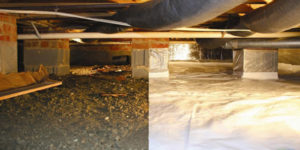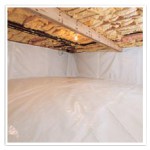AquaTech Blog
ADVANTAGES OF A SEALED CRAWLSPACE
 There are many advantages of sealing (or ‘encapsulating’) your crawlspace. The most obvious is mold prevention. Because of the way in which moisture can become trapped underneath a house, unsealed crawlspaces are a breeding ground for all sorts of mildew and bacteria as a result of condensation. Another huge improvement can be seen in energy costs after sealing a crawlspace. Because cold air is unable to get under the house, the heating system does not have to work as hard to maintain a comfortable temperature inside the home. The same effect can be seen in warmer months by keeping hot air out, increasing the air conditioning’s efficiency.
There are many advantages of sealing (or ‘encapsulating’) your crawlspace. The most obvious is mold prevention. Because of the way in which moisture can become trapped underneath a house, unsealed crawlspaces are a breeding ground for all sorts of mildew and bacteria as a result of condensation. Another huge improvement can be seen in energy costs after sealing a crawlspace. Because cold air is unable to get under the house, the heating system does not have to work as hard to maintain a comfortable temperature inside the home. The same effect can be seen in warmer months by keeping hot air out, increasing the air conditioning’s efficiency.
A clean and sealed crawlspace is much more accessible than one without the treatment. Sticks, leaves, and debris can make their way under the house and lead to pest in-habitation. Anytime that something below the home needs service the person working under the house will charge for time spent cleaning up the area they need to access. Because many homes are built on organic wooden beams and floor joists they are susceptible to decay over time. Structural safety is one aspect of crawlspace cleanliness that will have a long-term effect on the home if mold is allowed to develop and moisture is not kept out of the crawlspace. Erosion and decay can occur in extreme instances of neglect over several years.
HEALTH CONCERNS ASSOCIATED WITH A MOLDY CRAWLSPACE
The  crawlspace is the darkest and dankest area of the home and because of this is often avoided. When neglected, condensation can build up developing moisture which can make it’s way into the organic wood beams. Over time this moisture grows into mold and mildew. Crawlspace mold is often overlooked by homeowners and can impact health if no action is taken. Coughing and shortness of breath as well as lung and eye irritation can occur when moldy air is circulated throughout the home.
crawlspace is the darkest and dankest area of the home and because of this is often avoided. When neglected, condensation can build up developing moisture which can make it’s way into the organic wood beams. Over time this moisture grows into mold and mildew. Crawlspace mold is often overlooked by homeowners and can impact health if no action is taken. Coughing and shortness of breath as well as lung and eye irritation can occur when moldy air is circulated throughout the home.
Summertime is when mold is most likely to grow in your crawlspace. When the outside air is much warmer than the cool musty air of the crawlspace condensation easily develops. The solution is to encapsulate your crawlspace. This is the act of waterproofing and sealing your crawlspace to keep it dry and clean. Applying a liner to the floor and walls of the area keeps moisture out and dry air in.
SIGNS OF MOLD IN YOUR BASEMENT
Below are some common signs to watch out for that could indicate you have mold growing in your house.
Allergic Symptoms from Mold
Do you notice your allergic reactions are worse when you’re at home but you feel better when you go out? If so then it’s especially likely you could have mold. If you find that your allergies are worse in some other building, like your workplace, then there could be mold growing there instead.
Smelling a Mold Odor
When you have mold growing hidden away in your house, often a moldy smell might be the only clue that it’s there. Don’t ignore mold odors if you can’t see any mold. You should thoroughly inspect your home before any mold problems get worse.
Seeing Signs of Mold Growth
Visible mold growth might seem like an obvious sign of mold. However many people don’t notice small amounts of mold growth or they think it’s just soot or dirt. Sometimes people simply ignore visible mold in their house.
If you can see mold growth, even if it’s only small, you should take action immediately. Small mold patches can spread and the fact that there is any mold shows that the conditions in your home are right for mold to grow.
If you don’t take care of mold it will soon become a bigger problem. Visible mold growth could also be a sign that there is a much larger mold colony growing hidden away from view.
Sometimes you might not realize there is mold in your house, especially if it is unusual looking mold. Some mold growth looks white and thread-like. Other mold appears as clusters of small black spots. Mold can be black, gray-brown, gray-green or white in color. Mold growing behind wallpaper made of vinyl can even appear orange, pink or purple.
Signs of Water Problems
If you have had any long term moisture problems in your house it’s usually inevitable they will lead to mold beginning to grow. So if you know you’ve had some water problems in your home then it’s a pretty good sign you could have mold.
Some signs that you have a moisture problem include water stains or discoloration on walls, floors or ceilings in your house. Seeing these could be a clue that there is mold growing within or behind the material.
Another sign of a moisture problem is surface abnormalities like peeling, bubbling or cracking of the paint or wallpaper. If your walls are bowed, bulging or warped it probably means moisture has gotten into them. Another clue is if the surface of walls or other materials feel damp.
Water Leaks
 The above signs of water problems in homes are usually created by leaks. However if you already know that you have had a water leak (such as leaking pipes or a leaking ceiling) then just that knowledge by itself, even if you don’t see signs of water damage, is a good sign that you might have mold growing in your house around the area where the leak was.
The above signs of water problems in homes are usually created by leaks. However if you already know that you have had a water leak (such as leaking pipes or a leaking ceiling) then just that knowledge by itself, even if you don’t see signs of water damage, is a good sign that you might have mold growing in your house around the area where the leak was.
Mold growth from leaks can often be hidden. If the leak was behind a wall or other surface then any mold will probably be hidden behind the surface too. Even if the leak was not behind a surface there could still be mold hidden out of view behind a wall or other surface from water which seeped through.
Past Flooding
If your house has been flooded in the past then it’s likely that mold would’ve started to grow. Any mold would probably be growing in places where flood water remained the longest such as in the basement. Floods can often create mold growing out of view behind walls or under floors.
Condensation
If you see a lot of condensation in your home then it’s a sign that you have a high amount of moisture and hence a sign that you could have a mold problem. Condensation will occur on surfaces such as glass windows or metal pipes. Mold could be growing where the condensation builds up and collects. Rusting indoor pipes are a sign that you could have a lot of condensation in your house.
Besides the fact that condensation creates a build up of moisture for mold to grow on, condensation can also be a sign that you have a humidity problem in your home. A high humidity level can feed mold and it is another sign that you might have a potential mold problem.
Toxic Symptoms from Mold
If you suffer neurological symptoms such as headaches, trouble concentrating, shortened attention span, memory loss and dizziness it could be a sign that there is toxic mold growing somewhere in your house which is poisoning you.
See Moldpedia.com for more information.
AQUATECH SERVES CHARLOTTE AND THE SURROUNDING AREA
 AquaTech is a Christ based company, which handles all of your crawlspace, basement, drainage and waterproofing needs. We give free evaluations and quotes for new construction and existing homes. We provide you with references and work in both North Carolina and South Carolina. AquaTech fully warranties all work and is fully insured. We are licensed contractors in both North Carolina and South Carolina. AquaTech Foundation & Waterproofing has been serving the Charlotte and surrounding areas for over 16 years. We can handle all of your crawlspace, basement and foundation needs.
AquaTech is a Christ based company, which handles all of your crawlspace, basement, drainage and waterproofing needs. We give free evaluations and quotes for new construction and existing homes. We provide you with references and work in both North Carolina and South Carolina. AquaTech fully warranties all work and is fully insured. We are licensed contractors in both North Carolina and South Carolina. AquaTech Foundation & Waterproofing has been serving the Charlotte and surrounding areas for over 16 years. We can handle all of your crawlspace, basement and foundation needs.
Call 704-841-7638 today for your FREE inspection! Or use the Contact Us form to send us a request via email.